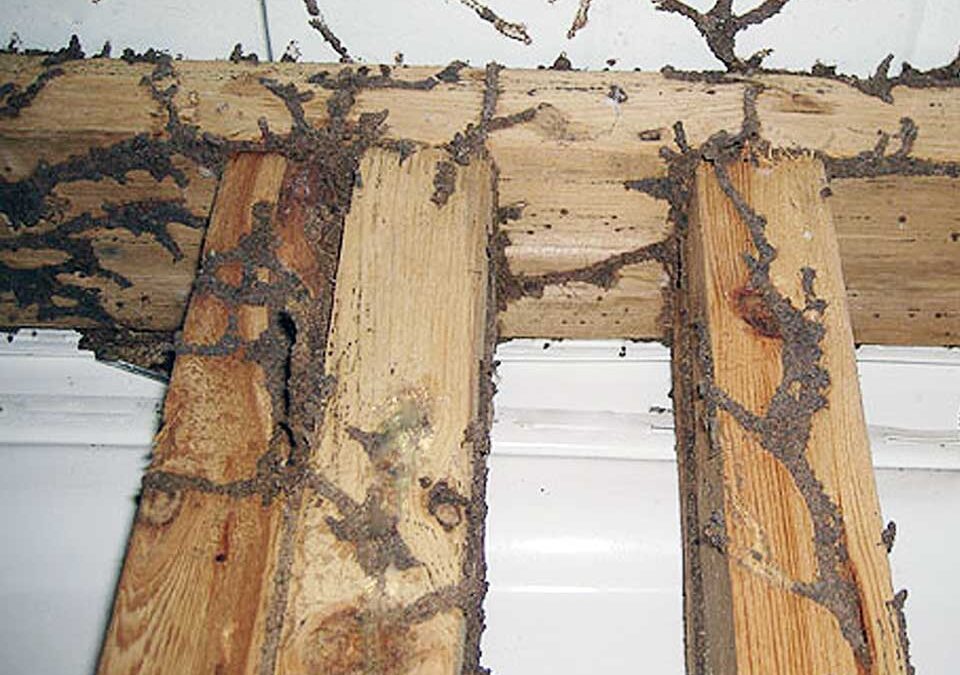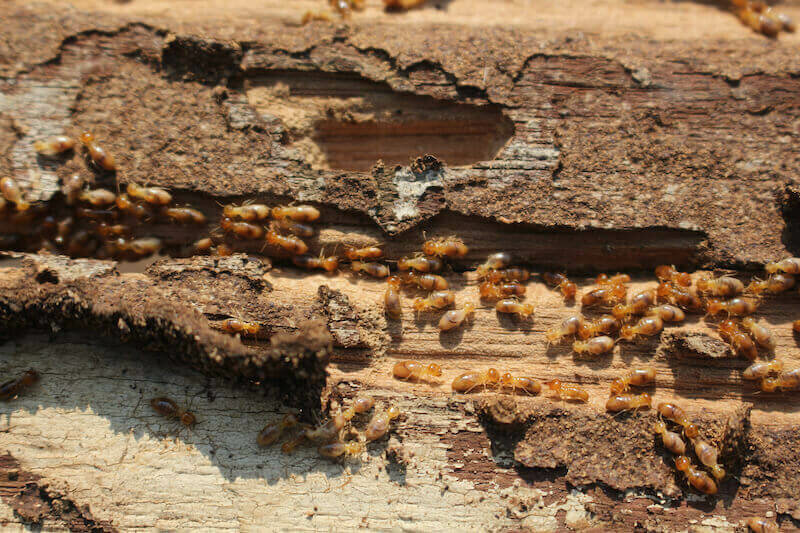Florida’s subtropical setting characterized by warm temperatures, high humidity, and generally mild winter weather allows termites to remain active nearly all year. In Panama City, a popular coastal destination in the Florida Panhandle, these wood-devouring insects can invade single-family homes, short-term rentals, or commercial properties if early detection fails or protective measures lapse. By the time hollow-sounding wood or subtle mud tubes appear, termites may have already compromised support beams, floors, or even interior walls. This service page explores why termites thrive in Florida, how to recognize their presence, and why relying on a professional termite exterminator is the most effective path to preserving the structural integrity of your property.
Whether you own a residence in Panama City or manage rentals across Panama City Beach and Lynn Haven, spotting termites quickly and using specialized, multi-stage solutions safeguards occupants from deeper damage, spiraling repair bills, and prolonged do-it-yourself attempts that often ignore hidden colonies or ongoing egg-laying cycles concealed in wooden beams or below floors.
Why Termites Thrive in Florida
Mild Winter Temperatures
In colder regions, harsh freezing conditions help curb termite populations for months. Florida’s gentle cold season rarely hits freezing, permitting termites to forage and lay eggs inside or underground all year. Climate-controlled interiors (roughly 65–85°F) remove seasonal pauses, allowing each termite stage egg, larva, soldier, worker to progress uninterrupted if occupant or property manager diligence is lacking.
High Humidity & Damp Soil
Subterranean termites require moisture to build mud tubes and support colony activities, while drywood termites slip into tiny attic or roof gaps to nest. Florida’s periodic rainfall, lawn irrigation, or minor home leaks maintain sufficient humidity for subterranean termite foraging. Even minimal water from air conditioners or small pipe leaks can attract termites to soggy wood behind walls.
Ample Wood Structures
From framing lumber to baseboards and deck boards, Florida properties often incorporate plentiful wooden materials for termites to consume if occupant or manager detection is slow. Damp or untreated wood, or posts directly contacting soil, particularly entices subterranean termites. Drywood termites prey on attic beams and furniture, quietly tunneling from the inside out.
Rapid Colony Growth
A single termite queen lays multiple eggs daily, and eggs hatch swiftly under Florida’s mild climate. Subterranean termites, especially, expand through underground galleries linking them to new wooden targets, while drywood species spread between rafters or furniture if occupant or professional action doesn’t disrupt them. A seemingly small termite presence can soon undermine entire rooms.

Telltale Signs of a Termite Infestation
- Mud Tubes
- Pencil-thin, earthen tunnels built along foundation walls or support beams.
- Subterranean termites travel through these to retain moisture while accessing wood.
- Pencil-thin, earthen tunnels built along foundation walls or support beams.
- Discarded Wings
- Winged termites (swarmers) shed transparent wings after mating, leaving small piles near window sills, door frames, or light fixtures.
- This indicates a recently established or nearby colony.
- Winged termites (swarmers) shed transparent wings after mating, leaving small piles near window sills, door frames, or light fixtures.
- Hollow or Damaged Wood
- Termites feed internally, leaving only a thin outer veneer that sounds hollow when tapped.
- Light blistering or peeling paint can mask internal termite foraging tunnels.
- Termites feed internally, leaving only a thin outer veneer that sounds hollow when tapped.
- Drywood Termite Frass
- Tiny, ridged pellets resembling sawdust near holes in beams or furniture.
- Signals drywood termites pushing excrement out from their tunnels.
- Tiny, ridged pellets resembling sawdust near holes in beams or furniture.
- Swarmers
- Winged termites emerge during warm, humid periods to begin new colonies.
- Spotting swarmers indoors suggests a large, established colony in or near the structure.
- Winged termites emerge during warm, humid periods to begin new colonies.
- Stuck Windows or Doors
- Damaged wooden frames expand, making windows or doors challenging to open or close properly.
- When coupled with other evidence, suspect significant termite tunneling or moisture-laden wood.
- Damaged wooden frames expand, making windows or doors challenging to open or close properly.
Risks of Overlooking Termites
Progressive Structural Damage
Termites hollow out wood from within, destabilizing floors, beams, or substructures. If unchecked, advanced colonies can cause pronounced sagging or cracking in walls, sometimes leading to partial collapse that forces occupant relocation or costly repairs.
Colony Expansion
Subterranean termites frequently create underground passageways to adjacent buildings if occupant or manager checks remain incomplete. Drywood termites develop satellite nests in rafters or furnishings, quietly devouring wood out of sight.
Rising Repair & Treatment Costs
Minor termite sightings found early may only demand localized chemicals or partial fumigation. Allowing termites to saturate multiple floors or hide behind walls usually forces occupant displacement for entire-structure fumigation or repeated insecticide applications, escalating occupant inconvenience and final expenses.
Anxiety & Insurance Limitations
Standard homeowner’s insurance typically excludes termite-related damage, leaving owners liable for repairs. Anxiety over unseen wood destruction intensifies occupant stress or occupant dissatisfaction until professionals confirm termite elimination and structural safety.
Why a Professional Termite Exterminator Is Vital
Thorough Property Reviews
A termite exterminator investigates crawl spaces, foundations, attics, or yard edges for mud tubes, discarded wings, or hollow wood. Identifying subterranean vs. drywood (or Formosan) termites clarifies whether soil termiticides, fumigation, or foam injections are best.
Colony-Wide Elimination
DIY termite sprays kill surface insects but miss queens or deeper nests hidden in walls or underground. Professional termite treatments typically employ:
- Soil Termiticides: Injected around foundations to kill or repel subterranean termites.
- Bait Stations: Slow-acting poisons placed around the property perimeter, carried by worker termites to the nest.
- Fumigation (Tenting): Used for severe or widespread drywood termite invasions.
- Localized Treatments: Foams or liquids injected into smaller pockets if occupant or manager catches infestations early.
Safe, Regulated Chemical Placement
Applying chemicals improperly can endanger occupant health or damage the environment. Certified exterminators place termiticides methodically trenching soil near foundations, sealing entire structures for fumigation, or injecting foam into hollow beams ensuring termite contact without occupant risk.
Moisture & Entry Control
Subterranean termites require constant moisture, so occupant synergy fixing leaks, directing water away from foundations cuts termite access. Drywood termite swarmers typically enter via roof eaves or attic vents; sealing these spots denies them re-entry after extermination.
Monitoring & Service Plans
Many termite exterminators offer warranties or check-ups. Occupants find confidence if future mud tubes, frass, or swarmers reappear, guaranteeing immediate re-treatment. Prompt occupant or manager detection halts new colonies well before major structural harm.

Common Termite Treatment Methods
- Inspection & Species ID
- Professionals scan foundations, attics, crawl spaces, or yard edges for mud tubes, weak wood, or termite droppings.
- Subterranean vs. drywood identification informs whether soil barriers, fumigation, or localized foams best suit occupant needs.
- Professionals scan foundations, attics, crawl spaces, or yard edges for mud tubes, weak wood, or termite droppings.
- Soil Termiticides
- For subterranean termites, exterminators dig or drill around foundations, injecting or trenching termiticides.
- Termites crossing treated soil pick up poison, contaminating and collapsing the colony from inside.
- For subterranean termites, exterminators dig or drill around foundations, injecting or trenching termiticides.
- Bait Stations
- Slow-acting toxins placed at property perimeters, typically near known termite foraging routes.
- Worker termites ingest poison, spreading it throughout the nest impacting the queen, soldiers, and other members.
- Slow-acting toxins placed at property perimeters, typically near known termite foraging routes.
- Fumigation (Tenting)
- If drywood termites saturate multiple rooms or floors, sealing the structure under a tarp and using gas kills infestations deep in wood layers.
- Occupants vacate for a few days while exterminators confirm total termite eradication and safe re-entry.
- If drywood termites saturate multiple rooms or floors, sealing the structure under a tarp and using gas kills infestations deep in wood layers.
- Localized Treatments
- Smaller drywood termite pockets may only need foam or liquid spot injections directly into infested wood.
- Follow-up ensures no overlooked expansions or connected satellite colonies remain active.
- Smaller drywood termite pockets may only need foam or liquid spot injections directly into infested wood.
- Moisture Reduction & Wood Repairs
- Subterranean termites rely on moist soil. Occupants fix leaks, slope soil away from foundations, or replace damp wood.
- Sealing eaves or attic vents prevents drywood swarmers from re-entering.
- Subterranean termites rely on moist soil. Occupants fix leaks, slope soil away from foundations, or replace damp wood.
- Annual Inspections & Warranty
- Occupant or manager synergy plus professional yearly checks for fresh mud tubes, frass, or discarded wings.
- Swift occupant response when suspicious signs arise blocks new colonies before extensive wood damage unfolds.
- Occupant or manager synergy plus professional yearly checks for fresh mud tubes, frass, or discarded wings.
- Inspection & Species ID

Service Areas: Panama City, Panama City Beach, Lynn Haven
Though termites flourish statewide in Florida’s mild winter environment, this page concentrates on Panama City and nearby Panama City Beach, Lynn Haven all requiring occupant synergy plus specialized termite treatments for complete colony removal or prevention. Florida’s gentle cold season seldom hinders termite egg-laying or feeding cycles, so occupant diligence and professional approaches remain crucial to defending your property’s structure from these silent invaders.
Why Choose Us
Florida-Oriented Solutions
We blend recognized termite control soil termiticides, fumigations, bait stations to match Florida’s climate, pairing occupant synergy (like moisture management or sealing cracks) for thorough coverage. Occupant or manager synergy outperforms occupant do-it-yourself attempts, often failing to address concealed colony expansions or ongoing queen egg-laying behind walls.
Comprehensive Property Inspections
Before deploying chemicals, technicians meticulously assess foundations, attics, or basements for mud tubes, frass, or soft wood. Identifying whether subterranean or drywood (or both) shapes partial foam solutions or entire-structure fumigation, ensuring occupant satisfaction.
Safe & Precisely Applied Treatments
Professionals place termiticides responsibly like trenching around foundations for subterranean species, or tenting for advanced drywood infestations protecting occupant well-being and the environment. Local foam injections remain confined to termite galleries, delivering lethal doses while minimizing occupant chemical contact.
Moisture & Entry Prevention
Once colonies are eliminated, occupant synergy repairing leaks, removing wood-to-soil contact prevents subterranean re-entry. Sealing attic cracks or roof eaves stops drywood swarmers from returning. Florida’s mild winter never fully suppresses termite feeding, so occupant synergy cements lasting termite defenses.
Follow-Up & Warranty Options
Because new colonies can emerge, many termite exterminators offer warranties or routine checks for new mud tubes or frass. Occupants rest assured that fresh infestations meet immediate, guaranteed solutions, maintaining a termite-free property over Florida’s mild winter months.
Next Steps
Seeing mud tubes along foundations, noticing hollow-sounding wood, or discovering discarded termite wings near windows? Contact us to learn more or schedule your service. Our termite treatments for Panama City and the surrounding regions of Panama City Beach, Lynn Haven incorporate property-wide inspections, tried-and-true solutions (soil termiticides, fumigation, bait stations, localized foam), occupant-driven moisture control, plus necessary follow-ups eradicating established colonies while preventing new swarms.
Act fast to protect occupants from extensive wood damage, occupant worry over hidden termite foraging, and property insurance gaps not covering termite destruction. Trust our Florida-based termite exterminator skill to locate, destroy, and deter these stealthy pests, maintaining your property’s structural strength under Florida’s mild winter climate that otherwise sustains continuous termite feeding cycles year-round.
